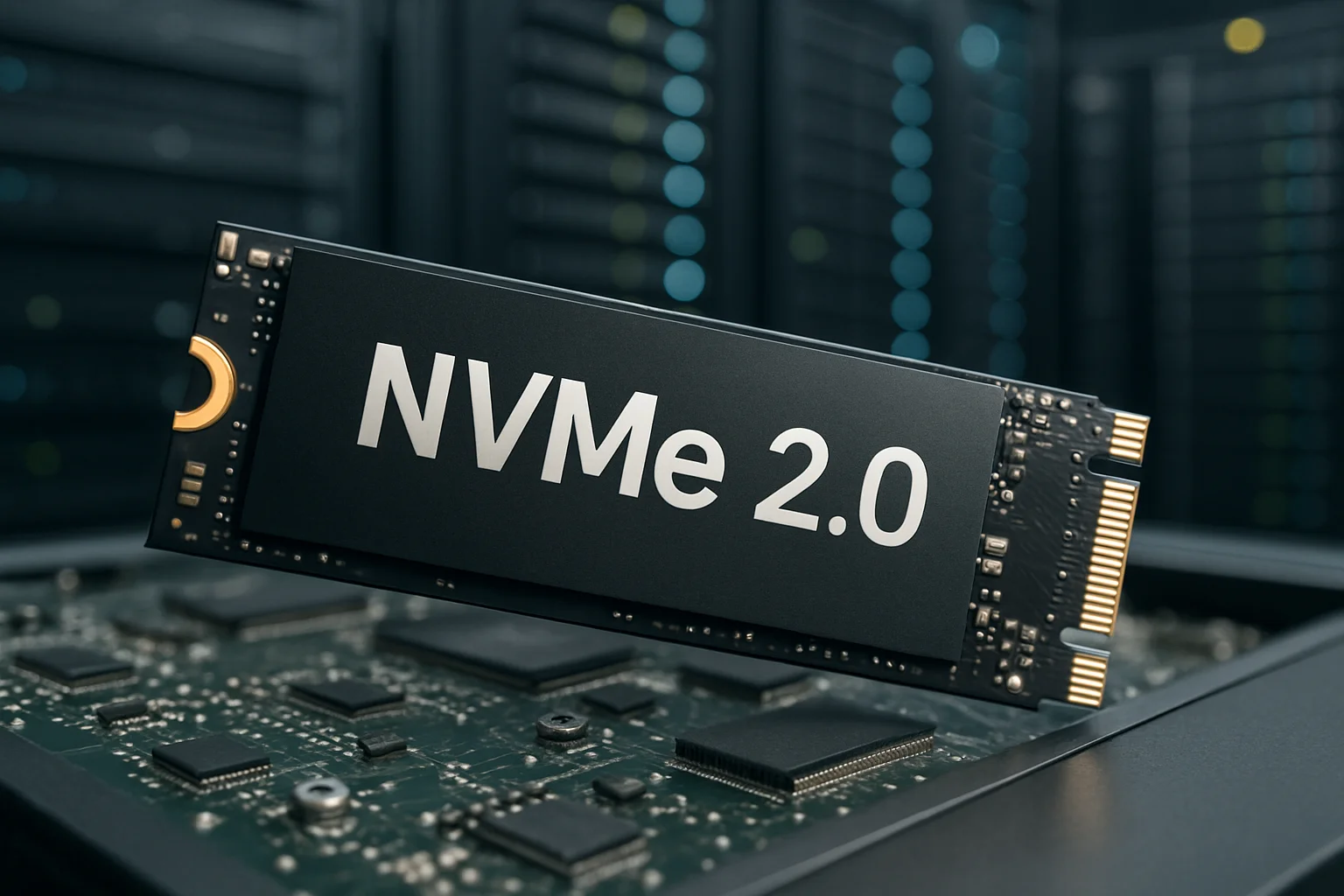What is NVMe 2.0? Overview and Key Updates
NVMe 2.0 is the latest iteration of the Non-Volatile Memory Express (NVMe) standard, developed to further optimize the interface between solid-state drives (SSDs) and computer systems. Building on the foundation of earlier versions, NVMe 2.0 introduces a wide range of enhancements designed to improve performance, flexibility, and scalability for both enterprise and consumer applications.
One of the most significant updates in NVMe 2.0 is the introduction of a modular specification. This modularity breaks the standard into distinct components, allowing vendors to implement specific features without adopting the entire specification at once. This approach fosters faster innovation and easier integration of future improvements.
Another key update is the expanded support for new command sets. NVMe 2.0 includes protocols for Zoned Namespaces (ZNS), Key-Value (KV) storage, and Persistent Memory (PMEM). These new command sets enable more efficient data management, especially for large-scale and specialized storage environments.
In terms of performance enhancements, NVMe 2.0 introduces improvements to queue management and command execution, reducing latency and increasing throughput. The new version also enhances multi-path I/O capabilities, improving reliability and load balancing in complex storage architectures.
Security is another critical area addressed by NVMe 2.0. The updated standard includes improved encryption support and mechanisms for secure firmware updates, helping protect data integrity and system security against modern threats.
Finally, NVMe 2.0 improves interoperability and backward compatibility, ensuring that devices built on previous NVMe versions can still function smoothly while benefiting from the new capabilities when upgraded.
Performance Improvements in NVMe 2.0
NVMe 2.0 introduces several critical enhancements that push the performance boundaries of SSDs and storage systems. These improvements focus on optimizing data throughput, reducing latency, and enhancing the efficiency of I/O operations.
One major area of improvement is the queue management system. NVMe 2.0 refines how command queues are handled, allowing for better parallelism and reduced overhead when processing multiple I/O requests. This optimization results in higher input/output operations per second (IOPS) and improved responsiveness, especially under heavy workloads.
Latency reduction is also a core focus. The updated standard reduces the number of steps required for command submission and completion, streamlining communication between the host and the SSD. This means faster command processing and quicker data access, which is particularly beneficial for latency-sensitive applications such as real-time analytics and gaming.
NVMe 2.0 enhances multi-path I/O support as well, enabling more effective use of multiple data paths between the host and storage device. This feature not only improves overall performance by balancing the load across different paths but also increases reliability by providing redundancy in case of a path failure.
The new standard also introduces improvements in command execution efficiency, reducing CPU cycles spent on managing storage commands. This leads to lower system overhead and frees up processing power for other tasks, which can be crucial in data center environments where resource optimization is key.
Furthermore, NVMe 2.0 supports larger namespace sizes and better management of storage pools, enabling the handling of bigger datasets with minimal impact on performance. This scalability is essential as data volumes continue to grow exponentially.
Lastly, NVMe 2.0 is designed to work seamlessly with emerging PCIe 5.0 technology, unlocking even greater bandwidth potential. This forward compatibility ensures that devices leveraging the new PCIe standards can maximize the benefits of NVMe 2.0’s performance improvements.
New Features and Capabilities in NVMe 2.0
NVMe 2.0 introduces a suite of new features that significantly extend the functionality and adaptability of the NVMe protocol, catering to a wider range of use cases and storage technologies.
One of the standout capabilities is the formal integration of Zoned Namespaces (ZNS). ZNS allows storage devices to organize data into zones, enabling more efficient data placement and reducing write amplification. This feature is especially valuable for large-scale storage systems and cloud providers, as it improves endurance and overall drive longevity by optimizing how data is written and erased.
Another major addition is support for Key-Value (KV) storage. Unlike traditional block storage, KV storage allows applications to store and retrieve data using key-value pairs, simplifying data management and improving performance for workloads such as databases, caching systems, and IoT applications. NVMe 2.0 standardizes the command set for KV, enabling better interoperability between devices and software.
NVMe 2.0 also advances Persistent Memory (PMEM) support. This capability enhances the way storage devices interact with non-volatile memory technologies that combine the speed of RAM with the persistence of traditional storage. By optimizing commands and protocols around PMEM, NVMe 2.0 enables ultra-low latency data access, critical for real-time processing and high-frequency trading applications.
In addition, the new standard includes improved namespace management, allowing dynamic resizing, better isolation, and enhanced sharing capabilities. This makes it easier for administrators to allocate storage resources flexibly and securely across multiple tenants or applications.
NVMe 2.0 also introduces refined error reporting and telemetry features, which provide deeper insights into device health and performance metrics. These enhancements facilitate proactive maintenance and enable more sophisticated monitoring tools to detect and predict failures before they impact operations.
Another innovative capability is the expansion of security features, including enhanced encryption options and stronger authentication protocols. These improvements help protect data both at rest and in transit, aligning NVMe devices with modern security standards and regulatory requirements.
Finally, the standard emphasizes modularity by allowing device manufacturers to implement specific features independently. This flexibility accelerates the adoption of cutting-edge functionalities and supports a diverse ecosystem of devices optimized for various workloads.
Comparing NVMe 2.0 to Previous Versions
NVMe 2.0 builds upon the foundation established by earlier versions of the NVMe standard, but it introduces substantial changes that differentiate it significantly from its predecessors.
One of the most noticeable differences is the modular architecture introduced in NVMe 2.0. Unlike previous versions, which were more monolithic, this modular design breaks the specification into discrete components. This allows vendors to implement features selectively, enabling faster adoption and easier customization without waiting for the entire standard to be finalized.
In terms of command set expansions, NVMe 2.0 supports new specialized protocols such as Zoned Namespaces (ZNS) and Key-Value (KV) storage, which were either absent or only in early draft form in previous versions. These additions extend NVMe’s versatility beyond traditional block storage, opening new possibilities for data management and application optimization.
Performance improvements in NVMe 2.0 surpass those in earlier versions by refining queue handling, reducing latency, and enhancing multi-path I/O. While NVMe 1.x already delivered impressive speed gains over older storage interfaces like SATA, NVMe 2.0 optimizes internal processing and resource utilization to maximize throughput, especially under heavy or complex workloads.
Security and reliability features have also evolved. NVMe 2.0 integrates stronger encryption methods and improved firmware update processes, reflecting the growing importance of data protection. Earlier standards included baseline security, but NVMe 2.0 aligns better with modern security demands and compliance frameworks.
Backward compatibility remains a priority; devices and hosts supporting NVMe 2.0 can still operate with earlier NVMe implementations, ensuring a smooth transition. However, the enhanced capabilities of NVMe 2.0 require updated hardware and firmware to fully benefit from the new features.
Finally, NVMe 2.0’s support for emerging technologies like Persistent Memory (PMEM) and PCIe 5.0 is a clear step forward compared to previous versions. These integrations prepare the standard for future storage architectures, where ultra-low latency and massive bandwidth are critical.






